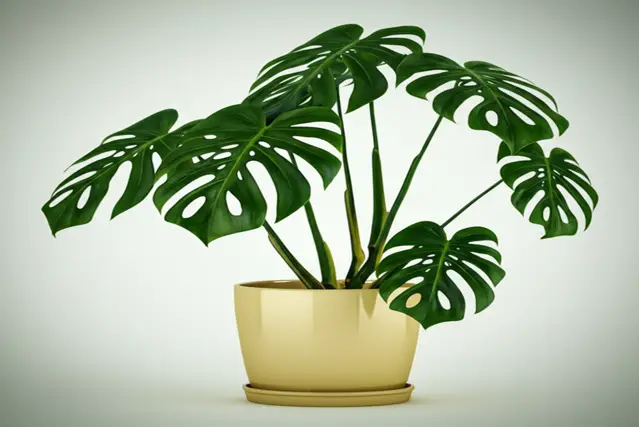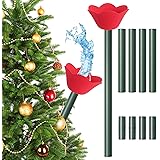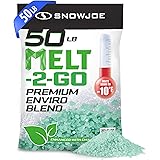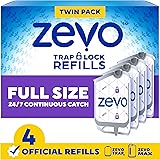The Monstera, with its iconic split leaves, has become a staple in homes across the globe. Its striking appearance and relatively easy care requirements make it a favorite among both novice and experienced plant enthusiasts. However, one of the most crucial aspects of Monstera care, and often the most confusing, is watering. Overwatering or underwatering can quickly lead to a sad, droopy, or even deceased Monstera. This comprehensive guide will delve into the intricacies of watering your Monstera, providing you with the knowledge to keep your plant thriving in 2024.
According to recent statistics, plant ownership has seen a significant surge, particularly among millennials and Gen Z. This trend is driven by a desire to connect with nature, improve indoor air quality, and enhance mental well-being. Monsteras are consistently ranked among the most popular houseplants, contributing to a booming industry that demands accurate and accessible care information. This guide aims to be that reliable resource for you.
Understanding Your Monstera: A Foundation for Watering
Before we dive into the specifics of watering, it’s important to understand the basic needs of your Monstera. Knowing where your plant comes from and how it grows in its natural environment will help you mimic those conditions at home.
Monstera’s Natural Habitat
Monsteras are native to the tropical rainforests of Central and South America. They are epiphytes, meaning they often grow on other plants or trees, using their aerial roots to cling to surfaces and absorb moisture and nutrients. In their natural habitat, Monsteras experience high humidity, filtered sunlight, and frequent rainfall, but the well-draining nature of the forest floor prevents their roots from sitting in soggy soil.
Different Monstera Varieties
While Monstera deliciosa is the most well-known variety, there are several other types of Monsteras, each with slightly different needs. Some popular varieties include:
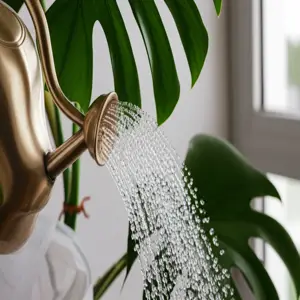
monstera watering schedule
- Monstera deliciosa: The classic split-leaf Monstera.
- Monstera adansonii: Also known as the Swiss Cheese Vine, with smaller leaves and numerous holes.
- Monstera borsigiana: Often mistaken for Monstera deliciosa, but typically smaller and grows faster.
- Monstera standleyana: A less common variety with solid green leaves and white variegation.
While the basic watering principles apply to all varieties, Monstera adansonii, for instance, may require slightly more frequent watering due to its smaller leaf size and faster growth rate. Always observe your specific plant and adjust your watering schedule accordingly. Consider checking out reputable botanical gardens’ websites for specific details on each variety. A great starting point would be the Missouri Botanical Garden website. You can find resources by searching for “Monstera varieties Missouri Botanical Garden” on your preferred search engine.
The Golden Rule: Water When the Soil is Dry
The most important principle to remember when watering your Monstera is to water only when the top few inches of soil are dry. This mimics the plant’s natural environment, where it experiences periods of rainfall followed by periods of drying. Overwatering is a much more common problem than underwatering, and it can lead to root rot, a deadly condition for your Monstera.
How to Check Soil Moisture
There are several ways to check the moisture level of your Monstera’s soil:
- The Finger Test: This is the simplest and most reliable method. Insert your finger about 2-3 inches into the soil. If the soil feels dry, it’s time to water. If it feels moist or wet, wait a few more days and check again.
- Moisture Meter: A moisture meter is a small device that you insert into the soil to get a reading of the moisture level. These are readily available online and at garden centers. Look for one that is specifically designed for plants and has a clear, easy-to-read display.
- Lifting the Pot: Over time, you’ll become familiar with the weight of your pot when the soil is dry versus when it’s wet. Lifting the pot can give you a good indication of whether it’s time to water. A dry pot will feel significantly lighter than a wet pot.
The Deep Watering Method
When it’s time to water, use the deep watering method. This involves thoroughly saturating the soil until water drains out of the drainage holes at the bottom of the pot. This ensures that all the roots are hydrated and helps to flush out any accumulated salts or minerals from the soil.
Avoid watering in small sips, as this can lead to a buildup of salts in the top layer of soil and can encourage shallow root growth. Deep watering encourages the roots to grow deeper into the pot, making the plant more resilient.
Read More: Why Is My Cast Iron Plant Turning Yellow? Find Solutions!
Watering Frequency: A General Guideline
As a general guideline, you should water your Monstera every 1-2 weeks. However, this is just a starting point, and the actual frequency will depend on several factors, which we’ll discuss in detail in the following sections. Always check the soil moisture before watering, and adjust your schedule accordingly.
Factors Influencing Watering Frequency
Several factors can affect how often your Monstera needs to be watered. Understanding these factors will allow you to create a watering schedule that is tailored to your plant’s specific needs.
Season
During the active growing season (spring and summer), Monsteras typically require more frequent watering. The warmer temperatures and increased sunlight encourage growth, which means the plant is using more water. You may need to water your Monstera once a week or even more frequently during these months.
In the dormant season (fall and winter), Monsteras require less water. Growth slows down, and the plant isn’t using as much water. You may only need to water your Monstera every 2-3 weeks during these months. It’s crucial to reduce watering frequency during the dormant season to prevent root rot. Many plant owners make the mistake of keeping the same watering schedule year-round, which can be detrimental to the plant during the colder months.
Light
The amount of light your Monstera receives also affects its watering needs. Monsteras prefer bright, indirect light. If your plant is in a location with very bright light, it will likely need more frequent watering than a plant in a shadier location. Conversely, if your Monstera is in a low-light environment, it will need less water. The increased light intensity accelerates photosynthesis, leading to faster water consumption.
Humidity
Monsteras thrive in high humidity environments. If your home is dry, you may need to water your Monstera less frequently, as the plant won’t be losing as much water through transpiration. You can increase the humidity around your Monstera by using a humidifier, placing it on a pebble tray, or grouping it with other plants. For example, if you live in Arizona, you likely need to water less often than someone in Florida due to the humidity difference.
Pot Size and Material
The size and material of your pot can also affect watering frequency. Monsteras typically do well in well-draining pots that are slightly larger than their root ball. If your pot is too large, the soil may retain too much water, leading to root rot. Terracotta pots are a good choice for Monsteras, as they are porous and allow the soil to dry out more quickly. Plastic pots retain more moisture, so you may need to water less frequently if your Monstera is in a plastic pot. For a Monstera in a 12-inch terracotta pot, you might water every 7-10 days in the summer, whereas in a plastic pot of the same size, you might extend that to 10-14 days.
Soil Type
The type of soil you use for your Monstera is crucial for proper drainage and water retention. Monsteras prefer a well-draining soil mix that is rich in organic matter. A good soil mix for Monsteras typically includes:
- Potting soil
- Perlite
- Coco coir or peat moss
This mix provides good drainage while still retaining enough moisture for the plant to thrive. Avoid using heavy, clay-based soils, as these can become waterlogged and lead to root rot. You can find pre-mixed Monstera-specific soil blends at many garden centers and online retailers. A good recipe would be 2 parts potting mix, 1 part perlite, and 1 part orchid bark.
Plant Size and Age
Larger, more mature Monsteras typically require more water than smaller, younger plants. This is because they have a larger root system and more leaves, which means they are using more water. You may need to water a large Monstera more frequently than a small one. Younger plants, on the other hand, have less developed root systems and may be more susceptible to overwatering. Adjust your watering accordingly as your Monstera grows.
Here’s a table summarizing the factors influencing watering frequency:
| Factor | Effect on Watering Frequency |
|---|---|
| Season (Spring/Summer) | Increased frequency |
| Season (Fall/Winter) | Decreased frequency |
| High Light | Increased frequency |
| Low Light | Decreased frequency |
| High Humidity | Decreased frequency |
| Low Humidity | Increased frequency |
| Terracotta Pot | Increased frequency |
| Plastic Pot | Decreased frequency |
| Well-Draining Soil | Increased frequency |
| Heavy Soil | Decreased frequency |
| Large Plant | Increased frequency |
| Small Plant | Decreased frequency |
Recognizing Overwatering
Overwatering is one of the most common mistakes people make when caring for Monsteras. It can lead to root rot, which is a serious condition that can kill your plant. It’s important to be able to recognize the signs of overwatering so you can take action before it’s too late.
Signs of Overwatering
- Yellowing Leaves: Yellowing leaves, especially those at the bottom of the plant, are a common sign of overwatering.
- Drooping Leaves: While drooping leaves can also be a sign of underwatering, they are often accompanied by yellowing leaves when caused by overwatering.
- Soft, Mushy Stems: If the stems of your Monstera feel soft and mushy, this is a sign of root rot.
- Brown Spots on Leaves: Brown spots, especially those with yellow halos, can indicate overwatering and fungal infections.
- Mold on Soil Surface: The presence of mold or mildew on the soil surface is a clear sign that the soil is staying too wet.
- Foul Odor from Soil: A foul or musty odor coming from the soil is a sign of root rot.
What to Do If You’ve Overwatered
If you suspect you’ve overwatered your Monstera, take the following steps:
- Stop Watering: Immediately stop watering your plant and allow the soil to dry out completely.
- Improve Air Circulation: Increase air circulation around your plant by opening a window or using a fan. This will help the soil dry out more quickly.
- Check the Roots: Gently remove your Monstera from its pot and inspect the roots. Healthy roots should be firm and white or light brown. If the roots are mushy and brown or black, they are rotting.
- Trim Rotting Roots: Use sterilized scissors or pruning shears to trim away any rotting roots. Be sure to remove all the affected tissue.
- Repot in Fresh Soil: Repot your Monstera in fresh, well-draining soil. Make sure the pot has adequate drainage holes.
- Consider a Fungicide: If the root rot is severe, you may want to consider using a fungicide to prevent further spread of the infection. Consult with a local garden center for recommendations.
- Monitor Closely: After repotting, monitor your Monstera closely for any signs of improvement or further decline. Avoid watering until the soil is completely dry.
Recognizing Underwatering
While overwatering is more common, underwatering can also harm your Monstera. It’s important to be able to recognize the signs of underwatering so you can take action before your plant suffers permanent damage.
Signs of Underwatering
- Drooping Leaves: Drooping leaves are a common sign of underwatering. The leaves may feel limp and lifeless.
- Crispy Brown Leaf Edges: Brown, crispy edges on the leaves are a classic sign of underwatering. This is because the plant is not getting enough water to support its leaves.
- Curling Leaves: Curling leaves can also indicate underwatering. The plant is trying to conserve water by reducing the surface area of its leaves.
- Dry Soil: The soil will be dry to the touch, even several inches below the surface.
- Stunted Growth: If your Monstera is not getting enough water, it may experience stunted growth.
What to Do If You’ve Underwatered
If you suspect you’ve underwatered your Monstera, take the following steps:
- Water Thoroughly: Water your Monstera thoroughly until water drains out of the drainage holes at the bottom of the pot.
- Soak the Pot (If Severely Dry): If the soil is extremely dry and compacted, you may need to soak the pot in a basin of water for a few hours to rehydrate the soil.
- Increase Humidity: Increase the humidity around your plant to help it recover from the stress of underwatering.
- Monitor Closely: Monitor your Monstera closely for signs of improvement. The leaves should start to perk up within a few days.
The Role of Water Quality
The quality of the water you use to water your Monstera can also affect its health. Tap water often contains chlorine, fluoride, and other chemicals that can be harmful to plants. Regulations on tap water vary widely, with the EPA setting standards in the US, and the EU having its own directives. It’s always best to be aware of your local water quality report, which is usually available from your water utility provider.
Best Water Options
- Rainwater: Rainwater is the best option for watering your Monstera. It is free of chemicals and contains beneficial nutrients.
- Distilled Water: Distilled water is another good option, as it is also free of chemicals.
- Filtered Water: If you don’t have access to rainwater or distilled water, filtered water is a good alternative. Use a water filter to remove chlorine and other chemicals from your tap water.
- Tap Water (Treated): If you must use tap water, let it sit out for 24-48 hours before watering your Monstera. This will allow the chlorine to evaporate.
Avoiding Hard Water
Avoid using hard water, as it can contain high levels of minerals that can build up in the soil and harm your Monstera. If your tap water is hard, consider using a water softener or one of the other water options mentioned above.
Fertilizing and Watering: A Symbiotic Relationship
Fertilizing your Monstera is an important part of its care, but it’s important to do it correctly. Over-fertilizing can be just as harmful as overwatering. The ideal time to fertilize is during the growing season, when the plant is actively using nutrients.
When to Fertilize
Fertilize your Monstera every 4-6 weeks during the spring and summer. Do not fertilize during the fall and winter, when the plant is dormant. When you fertilize, always water your Monstera first. This will help to prevent fertilizer burn.
Type of Fertilizer
Use a balanced liquid fertilizer diluted to half strength. Look for a fertilizer with an NPK ratio of 20-20-20 or similar. You can also use a fertilizer specifically formulated for houseplants. Organic fertilizers, like diluted fish emulsion, are also excellent choices.
Fertilizing Tips
- Always water your Monstera before fertilizing.
- Dilute the fertilizer to half strength to avoid fertilizer burn.
- Apply the fertilizer evenly to the soil.
- Avoid getting fertilizer on the leaves of the plant.
- Do not fertilize a dry plant.
Seasonal Adjustments to Your Watering Routine
As mentioned earlier, the seasons play a significant role in how often you should water your Monstera. Here’s a breakdown of how to adjust your watering routine based on the time of year.
Spring
Spring is the start of the growing season for Monsteras. As the days get longer and the temperatures rise, your plant will start to actively grow. Increase your watering frequency to once a week or even more often if needed. Monitor the soil moisture closely and water when the top few inches are dry. Begin fertilizing every 4-6 weeks.
Summer
Summer is the peak of the growing season. Your Monstera will be using a lot of water and nutrients. Continue to water regularly, checking the soil moisture frequently. You may need to water every few days during hot, dry periods. Continue fertilizing every 4-6 weeks.
Fall
As the days get shorter and the temperatures cool down, your Monstera’s growth will slow down. Reduce your watering frequency to every 2-3 weeks. Stop fertilizing altogether.
Winter
Winter is the dormant season for Monsteras. Your plant will need very little water during this time. Water only when the soil is completely dry, which may be every 3-4 weeks. Avoid fertilizing during the winter months. If you live in a particularly cold climate, ensure your Monstera is not placed near a drafty window, as this can further dry out the soil.
Here’s a table outlining a seasonal watering guide:
| Season | Watering Frequency | Fertilizing |
|---|---|---|
| Spring | Once a week (or more if needed) | Every 4-6 weeks |
| Summer | Every few days (depending on heat) | Every 4-6 weeks |
| Fall | Every 2-3 weeks | Stop fertilizing |
| Winter | Every 3-4 weeks (or when soil is dry) | Avoid fertilizing |
Troubleshooting Common Watering Issues
Even with the best intentions, you may still encounter some watering issues with your Monstera. Here are some common problems and how to troubleshoot them.
Yellowing Leaves
As mentioned earlier, yellowing leaves can be a sign of both overwatering and underwatering. Check the soil moisture to determine the cause. If the soil is wet, you’re likely overwatering. If the soil is dry, you’re likely underwatering.
Drooping Leaves
Drooping leaves can also be caused by both overwatering and underwatering. Again, check the soil moisture to determine the cause. Drooping can also be caused by low humidity or lack of light, so consider those factors as well.
Brown Spots on Leaves
Brown spots on leaves can be caused by several factors, including overwatering, underwatering, fungal infections, and fertilizer burn. Examine the spots closely to determine the cause. If the spots have yellow halos, it’s likely overwatering or a fungal infection. If the spots are dry and crispy, it’s likely underwatering. If the spots are brown and appear after fertilizing, it’s likely fertilizer burn.
Root Rot
Root rot is a serious condition that can kill your Monstera. It is caused by overwatering and poor drainage. If you suspect your Monstera has root rot, take the steps outlined earlier in this guide to address the problem.
Salt Buildup on Soil Surface
A white, crusty buildup on the soil surface is a sign of salt buildup. This is caused by using tap water or over-fertilizing. To fix this, flush the soil with distilled water or rainwater. Water the plant thoroughly until water drains out of the drainage holes at the bottom of the pot. Repeat this process several times to remove the salt buildup. You can also scrape off the top layer of soil and replace it with fresh soil.
Advanced Watering Techniques
Once you’ve mastered the basics of watering your Monstera, you can explore some advanced techniques to further improve its health and growth.
Self-Watering Pots
Self-watering pots can be a convenient option for Monsteras, especially if you tend to forget to water your plants. These pots have a reservoir at the bottom that holds water, which the plant can draw up as needed. However, it’s important to choose a self-watering pot that is the right size for your Monstera and to monitor the soil moisture to avoid overwatering. Always ensure the pot is not constantly saturated, as this can still lead to root rot.
Wick Watering
Wick watering is another method of self-watering that involves using a wick to draw water from a reservoir to the soil. This can be a good option for Monsteras, as it provides a consistent supply of moisture without overwatering. Similar to self-watering pots, monitor the soil moisture to prevent issues.
Using a Humidifier
As mentioned earlier, Monsteras thrive in high humidity environments. Using a humidifier can help to increase the humidity around your plant, which can reduce the need for frequent watering. This is especially beneficial during the dry winter months. Aim for a humidity level of 60-80% for optimal growth.
Grouping Plants Together
Grouping plants together can also help to increase humidity. Plants release moisture into the air through transpiration, which can create a more humid microclimate around them. Grouping your Monstera with other plants can help to keep it healthy and hydrated. This also creates a visually appealing display. Consider grouping your Monstera with other tropical plants that enjoy similar conditions.
Watering and Propagation
Watering plays a vital role in the propagation of Monsteras. Whether you’re propagating through stem cuttings or air layering, proper watering is essential for successful root development.
Stem Cuttings
When propagating Monsteras through stem cuttings, it’s important to keep the cuttings consistently moist but not waterlogged. You can root the cuttings in water or directly in soil. If rooting in water, change the water every few days to prevent bacterial growth. If rooting in soil, water the cuttings regularly to keep the soil moist. A rooting hormone can also aid in the process.
Air Layering
Air layering involves wrapping a section of stem with moist sphagnum moss until roots develop. It’s important to keep the sphagnum moss consistently moist but not soggy. Wrap the moss tightly with plastic wrap to retain moisture. Check the moss regularly and add water as needed. This technique allows you to propagate a larger plant section, which can result in a faster-growing new plant.
Monstera Watering and Common Myths
There are many myths and misconceptions surrounding Monstera watering. Let’s debunk some of the most common ones.
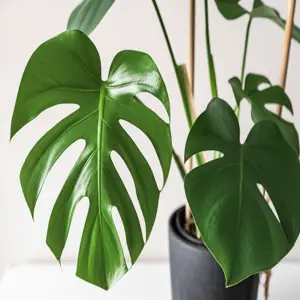
monstera moisture levels
Myth: Monsteras Need to Be Watered Every Day
This is absolutely false. Watering your Monstera every day will almost certainly lead to overwatering and root rot. Monsteras prefer to dry out slightly between waterings.
Myth: You Should Only Water When the Leaves Droop
While drooping leaves can be a sign of underwatering, it’s not a reliable indicator. By the time the leaves are drooping, your Monstera is already stressed. It’s better to check the soil moisture regularly and water before the leaves start to droop.
Myth: All Monsteras Need the Same Amount of Water
As we’ve discussed throughout this guide, the amount of water your Monstera needs depends on several factors, including the season, light, humidity, pot size, soil type, and plant size. There is no one-size-fits-all watering schedule for Monsteras.
Myth: Monsteras Can Tolerate Soggy Soil
Monsteras are very susceptible to root rot, which is caused by soggy soil. It’s important to use a well-draining soil mix and to avoid overwatering your plant.
Myth: You Should Only Use Tap Water to Water Your Monstera
Tap water can contain chemicals that are harmful to plants. It’s best to use rainwater, distilled water, or filtered water to water your Monstera. If you must use tap water, let it sit out for 24-48 hours to allow the chlorine to evaporate.
Regulations and Sustainable Watering Practices
While there are no specific regulations directly related to watering houseplants, it’s important to be mindful of water conservation and sustainable practices. With increasing concerns about water scarcity in many regions, adopting responsible watering habits is crucial.
Water Conservation Tips
- Collect Rainwater: Use rain barrels to collect rainwater for watering your plants.
- Water Early in the Morning: Water your plants early in the morning to reduce water loss through evaporation.
- Use a Watering Can: Using a watering can allows you to direct water precisely where it’s needed, minimizing waste.
- Mulch the Soil: Mulching the soil around your Monstera can help to retain moisture and reduce the need for frequent watering.
- Check for Leaks: Ensure your watering can and hose are not leaking, as this can waste a significant amount of water over time.
Sustainable Soil Practices
Choosing sustainable soil options is also important for environmentally responsible plant care. Peat moss, a common ingredient in potting mixes, is harvested from peat bogs, which are important carbon sinks. Consider using coco coir as a more sustainable alternative. Coco coir is made from coconut husks, which are a byproduct of the coconut industry. Additionally, composting your own organic waste can provide nutrient-rich soil amendments for your Monstera.
The Future of Monstera Care and Watering Techniques
As technology advances, we can expect to see even more innovative approaches to Monstera care and watering. Smart plant sensors, for example, are becoming increasingly popular. These sensors monitor soil moisture, light levels, and humidity, providing real-time data that can help you optimize your watering schedule. Many of these sensors connect to smartphone apps, allowing you to track your plant’s needs remotely.
Another trend is the growing use of hydroponics and semi-hydroponics for growing Monsteras. These methods involve growing plants in water or inert substrates, such as LECA (lightweight expanded clay aggregate), rather than soil. Hydroponics and semi-hydroponics can provide precise control over nutrient delivery and watering, leading to faster growth and healthier plants. However, these methods require a good understanding of plant nutrition and can be more complex than traditional soil-based growing.
Real-World Examples of Monstera Watering Schedules
To give you a better idea of how watering schedules can vary, let’s look at some real-world examples.
- Example 1: Apartment in New York City: A Monstera in an apartment in New York City, with bright indirect light and average humidity, might need to be watered every 7-10 days in the summer and every 2-3 weeks in the winter.
- Example 2: House in Florida: A Monstera in a house in Florida, with high humidity and partial shade, might only need to be watered every 10-14 days in the summer and every 3-4 weeks in the winter.
- Example 3: Home Office in Colorado: A Monstera in a home office in Colorado, with low humidity and bright light, might need to be watered every 5-7 days in the summer and every 1-2 weeks in the winter.
These are just examples, and your specific watering schedule will depend on your own unique conditions. Always monitor your plant closely and adjust your watering accordingly.
A Visual Guide to Monstera Watering
Visual aids can be incredibly helpful for understanding Monstera watering. Consider these resources:
- YouTube Videos: Search for “Monstera watering guide” on YouTube for a variety of video tutorials.
- Infographics: Look for infographics online that summarize the key points of Monstera watering. Pinterest is a great place to find these.
- Instagram: Follow plant influencers and enthusiasts on Instagram for visual inspiration and care tips. Many share their watering routines and plant care journeys.
By combining this comprehensive guide with visual resources, you’ll be well-equipped to provide the best possible care for your Monstera.
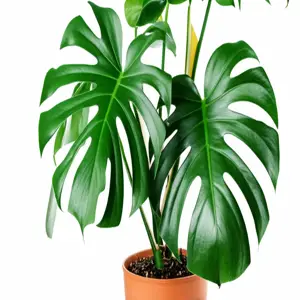
monstera plant care
Resources and Further Reading
To deepen your understanding of Monstera care, consider these additional resources:
- University Extension Services: Many universities offer online resources and publications on plant care. Search for your local university extension service.
- Botanical Gardens: Websites of botanical gardens, such as the Missouri Botanical Garden, offer detailed information on plant species and care.
- Plant Care Books: There are numerous books available on houseplant care, including specific guides to Monsteras.
- Online Forums and Communities: Engage with other plant enthusiasts in online forums and communities to share tips and ask questions.
Read More: Holes in Peace Lily Leaves: Causes, Prevention, and Treatment
FAQ: Your Monstera Watering Questions Answered
Here are some frequently asked questions about watering Monstera plants:
How do I know if I am overwatering my Monstera?
Signs of overwatering include yellowing leaves (especially at the bottom), drooping leaves accompanied by yellowing, soft and mushy stems, brown spots on leaves with yellow halos, mold on the soil surface, and a foul odor coming from the soil.
What are the signs of underwatering a Monstera?
Signs of underwatering include drooping leaves, crispy brown leaf edges, curling leaves, dry soil (even several inches below the surface), and stunted growth.
Should I use tap water to water my Monstera?
It’s best to avoid using tap water if possible, as it often contains chlorine and other chemicals that can be harmful to plants. Rainwater, distilled water, or filtered water are better options. If you must use tap water, let it sit out for 24-48 hours to allow the chlorine to evaporate.
How often should I water my Monstera in the winter?
During the dormant season (fall and winter), Monsteras require less water. You may only need to water your Monstera every 2-4 weeks, depending on the conditions in your home. Always check the soil moisture before watering.
What type of pot is best for a Monstera?
Terracotta pots are a good choice for Monsteras, as they are porous and allow the soil to dry out more quickly. Plastic pots retain more moisture, so you may need to water less frequently if your Monstera is in a plastic pot. Make sure the pot has adequate drainage holes.
What kind of soil should I use for my Monstera?
Monsteras prefer a well-draining soil mix that is rich in organic matter. A good soil mix typically includes potting soil, perlite, and coco coir or peat moss.
Is it better to water my Monstera from the top or the bottom?
Watering from the top is generally preferred, as it helps to flush out any accumulated salts or minerals from the soil. However, bottom watering can be a good option if you’re having trouble getting the soil to absorb water. If bottom watering, ensure the pot only sits in the water for a short period to prevent over-saturation.
How do I fix root rot in my Monstera?
To fix root rot, stop watering immediately, improve air circulation, check the roots (trimming away any rotting roots), repot in fresh soil, and consider using a fungicide.
Does humidity affect how often I should water my Monstera?
Yes, humidity plays a significant role. In high humidity environments, you’ll need to water less frequently, as the plant won’t be losing as much water through transpiration. In low humidity environments, you’ll need to water more frequently.
Can I use a moisture meter to check the soil?
Yes, a moisture meter can be a helpful tool for checking the moisture level of your Monstera’s soil. However, it’s still important to use your other senses (sight and touch) to assess the overall health of the plant.
Conclusion: Final Thoughts on Watering Your Monstera
Watering your Monstera may seem daunting at first, but with the right knowledge and observation, it becomes second nature. By understanding your plant’s natural habitat, checking soil moisture regularly, and adjusting for seasonal changes, you can prevent common pitfalls like overwatering and underwatering.
Key Takeaways for Perfect Monstera Watering:
- Check Soil Moisture First – Always water only when the top 2-3 inches of soil are dry.
- Deep Watering is Best – Saturate the soil thoroughly, allowing excess water to drain.
- Adjust for Seasons – Water more in spring/summer (every 1-2 weeks) and less in fall/winter (every 2-4 weeks).
- Consider Environmental Factors – Light, humidity, pot type, and soil mix all influence watering frequency.
- Watch for Warning Signs – Yellow leaves? Overwatering. Crispy edges? Underwatering.
- Use the Right Water – Rainwater, distilled, or filtered water is best to avoid chemical buildup.
Final Tip:
Your Monstera will communicate its needs—observe it closely and adjust care as needed. With patience and practice, you’ll develop a watering routine that keeps your plant lush and healthy for years to come.
Happy growing! 🌿💧
Auto Amazon Links: No products found.
Perfect Plants Christmas Tree Saver 8oz. | Easy Use Xmas Tree Preserver Food | Have Healthy Green Christmas Trees All Holiday Season
$9.97 (as of December 8, 2025 01:01 GMT +00:00 - More info- Product prices and availability are accurate as of the date/time indicated and are subject to change. Any price and availability information displayed on [relevant Amazon Site(s), as applicable] at the time of purchase will apply to the purchase of this product.
Kaiedos Christmas Tree Watering Funnel - 39 Inch Funnel, Reusable Design, Makes Watering Your Live Tree a Snap!
$14.99 (as of December 8, 2025 01:01 GMT +00:00 - More info- Product prices and availability are accurate as of the date/time indicated and are subject to change. Any price and availability information displayed on [relevant Amazon Site(s), as applicable] at the time of purchase will apply to the purchase of this product.
Forest Fresh Christmas Tree Preservative Tablets – Tree Water Additive for Live Fresh-Cut Trees – Keeps Trees Hydrated and Reduces Needle Drop – Non-Toxic, Made in USA – 1 Packet (8 Tablets)
$5.99 (as of December 8, 2025 01:01 GMT +00:00 - More info- Product prices and availability are accurate as of the date/time indicated and are subject to change. Any price and availability information displayed on [relevant Amazon Site(s), as applicable] at the time of purchase will apply to the purchase of this product.
Christmas Tree Watering Funnel-39 Inch Adjustable 3-Section Long Funnel Spout Funnel Watering System Xmas Plant Watering Tool for Large Indoor Outdoor Plants
$14.59 (as of December 8, 2025 01:01 GMT +00:00 - More info- Product prices and availability are accurate as of the date/time indicated and are subject to change. Any price and availability information displayed on [relevant Amazon Site(s), as applicable] at the time of purchase will apply to the purchase of this product.
EZMeetU Christmas Tree Watering Funnel, 47 Inch Flower Shape Adjustable 6 Section Design, Christmas Tree Watering System, Christmas Tree Waterer, Long Funnel Wide Opening Reusable, Plant Watering Tool
$15.99 (as of December 8, 2025 01:01 GMT +00:00 - More info- Product prices and availability are accurate as of the date/time indicated and are subject to change. Any price and availability information displayed on [relevant Amazon Site(s), as applicable] at the time of purchase will apply to the purchase of this product.
Muddy Mat® Shown on TV Super Absorbent Microfiber Dog Door Mat for Muddy Paws, Non-Slip Washable Pet Rug, Quick Dry Chenille Entryway Carpet, Machine Washable Indoor Outdoor mat, Grey 30"x19"
$24.95 (as of December 9, 2025 17:49 GMT +00:00 - More info- Product prices and availability are accurate as of the date/time indicated and are subject to change. Any price and availability information displayed on [relevant Amazon Site(s), as applicable] at the time of purchase will apply to the purchase of this product.
Snow Joe Premium Enviro Blend Ice Melt, Green-Coated Deicer Crystals, 50 lb - Safer Melter for Vegetation, Concrete & Metals w/ Anti-Corrosion Calcium Magnesium Acetate
$32.97 (as of December 9, 2025 17:49 GMT +00:00 - More info- Product prices and availability are accurate as of the date/time indicated and are subject to change. Any price and availability information displayed on [relevant Amazon Site(s), as applicable] at the time of purchase will apply to the purchase of this product.
Zevo Flying Insect Trap Official Refill Cartridges - Fits Both Zevo Trap & MAX Indoor Fly Trap - Authentic Trap+Lock Technology to Catch Gnats, House & Fruit Flys (4 Official Refill Cartridges)
$11.01 (as of December 9, 2025 17:49 GMT +00:00 - More info- Product prices and availability are accurate as of the date/time indicated and are subject to change. Any price and availability information displayed on [relevant Amazon Site(s), as applicable] at the time of purchase will apply to the purchase of this product.
OLANLY Dog Door Mat for Muddy Paws 30x20, Absorbs Moisture and Dirt, Absorbent Non-Slip Washable Doormat, Quick Dry Chenille Mud Mat for Dogs, Entry Indoor Entryway Carpet for Inside Floor, Grey
$9.99 (as of December 9, 2025 17:49 GMT +00:00 - More info- Product prices and availability are accurate as of the date/time indicated and are subject to change. Any price and availability information displayed on [relevant Amazon Site(s), as applicable] at the time of purchase will apply to the purchase of this product.
ivtivfu Rolling Grill Basket, Removable Wooden Handle, 304 Stainless Steel, Nesting BBQ Tools, Smoker Grilling Accessories for Vegetable, Outdoor Cooking Camping, Birthday Gifts for Men Dad Husband
$24.99 (as of December 9, 2025 17:49 GMT +00:00 - More info- Product prices and availability are accurate as of the date/time indicated and are subject to change. Any price and availability information displayed on [relevant Amazon Site(s), as applicable] at the time of purchase will apply to the purchase of this product.

